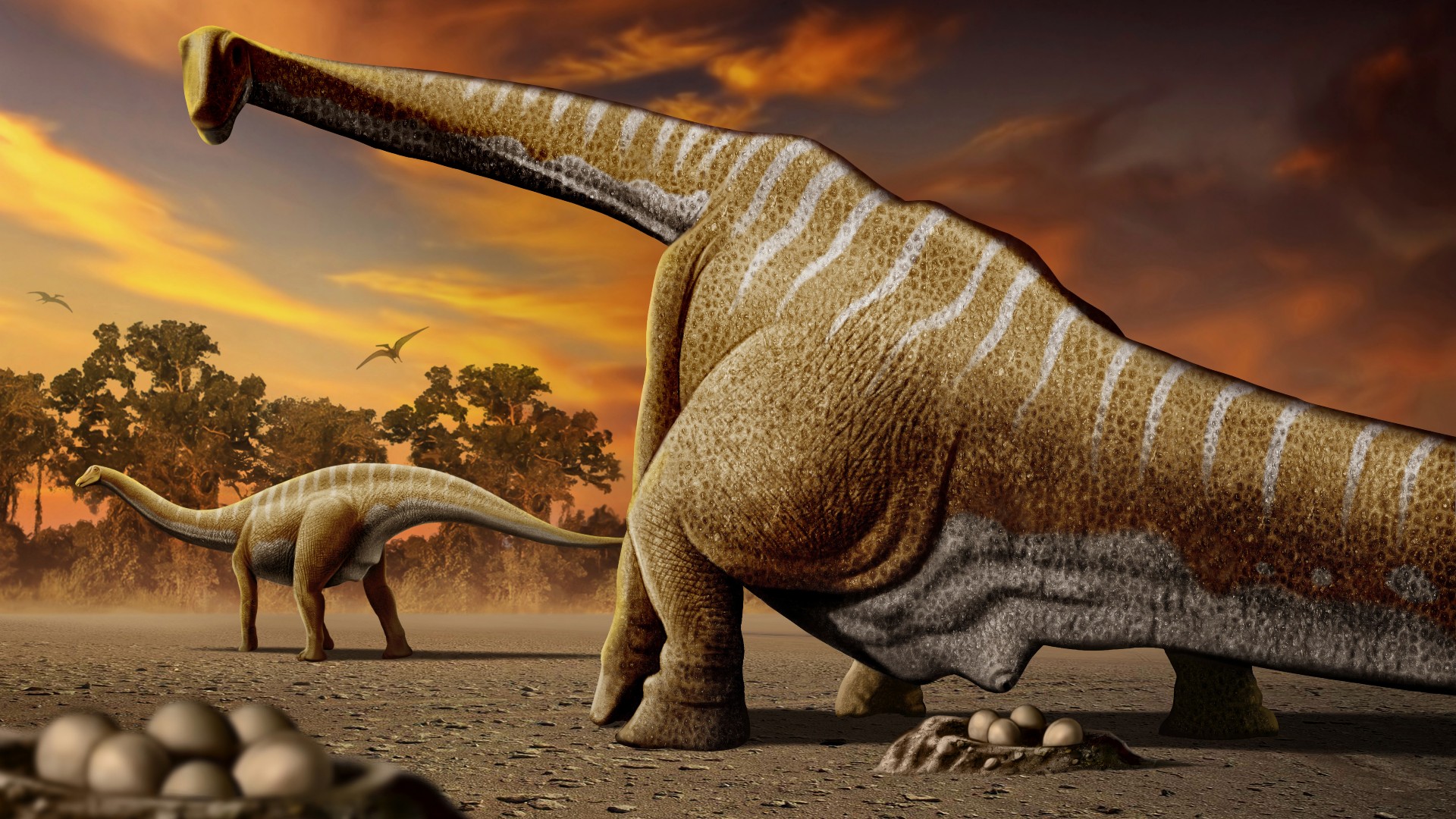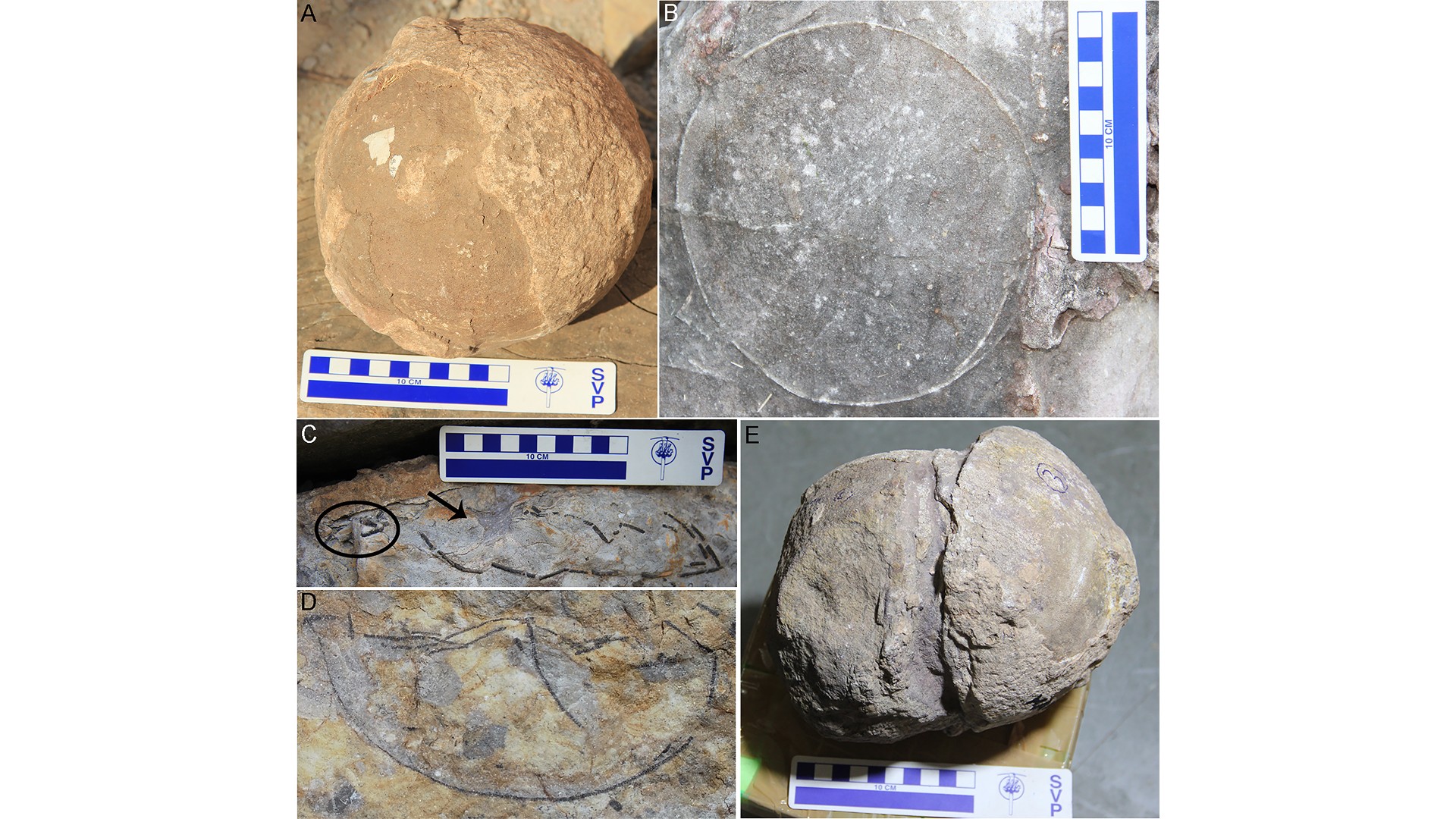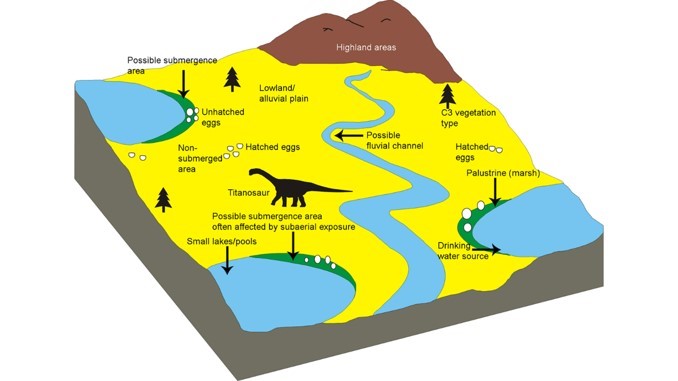'Staggering number' of titanosaur nests discovered in India reveals controversial findings about dino moms
The discovery of a tightly packed nesting ground from the Cretaceous period in India suggests that titanosaurs laid eggs and left their offspring behind.

About 70 million years ago, titanosaurs the length of school buses stomped through what is now west central India to lay their eggs by a riverbank. While these long-necked sauropods and the river are long gone, many of their nests remain intact, full of fossilized dinosaur eggs that reveal clues about how these massive herbivores nested and laid their eggs, and whether they took care of their hatchlings.
The nests, in the Indian state of Madhya Pradesh, are packed together so tightly that it's possible that titanosaur mothers abandoned their young soon after laying their eggs, so as not to crush their broods underfoot while navigating that narrow space, according to the study, published Jan. 18 in the journal PLOS One.
The researchers based the findings on the discovery of 92 nesting sites holding a total of 256 eggs, which were likely laid by six titanosaur species, they reported in the study.
"The sheer number of clutches and eggs means that there is a huge dataset to unpack in the coming years," Michael D. D'Emic, an associate professor of biology at Adelphi University who studies dinosaur evolution but was not involved in the present study, told Live Science in an email. However, he noted that it's unclear whether these eggs were laid at the same time or over many years, so it's unknown how tightly packed the "active" nests were.
Related: Impeccably preserved dinosaur embryo looks as if it 'died yesterday'

The authors uncovered this trove of titanosaur eggs through a series of field investigations carried out between 2017 and 2020. Upon examining the fossils, they discovered two families and six egg species (known as oospecies) — a big surprise.
"Currently, three titanosaurid taxa are known from the Cretaceous rocks of India," study first author Harsha Dhiman, a researcher in the Department of Geology at the University of Delhi, told Live Science in an email. The presence of six oospecies suggests that "more titanosaur species remain to be discovered" in the region, Dhiman said.
Sign up for the Live Science daily newsletter now
Get the world’s most fascinating discoveries delivered straight to your inbox.
Dhiman and colleagues also discovered a rare ovum-in-ovo, or egg-in-egg, specimen among the remains — an occurrence that has been reported only in birds. This happens when an egg that is about to be laid is pushed back into the mother's body, where it gets embedded into another, still-forming egg. As egg-in-egg events have not been documented in other reptiles, it's possible that titanosaurs had a similar reproductive system to those of modern birds, which are living dinosaurs, the researchers said in the study.
However, not everything the titanosaurs did was birdlike. The site hinted that titanosaurs laid their eggs as a clutch and partially buried them, like modern crocodiles do — an act that helps incubate the eggs through solar radiation and geothermal heat. Crocodiles are archosaurs, a group that includes dinosaurs, pterosaurs, crocodilians and birds. Just as modern crocodiles prefer nesting habitats closer to water sources, it's possible that some titanosaurs laid their eggs near the water because it was easy to partially bury them in the soft, water-logged sediments.
"The researchers deduce that these dinosaurs were burying their eggs in nests near lakes and rivers, not too dissimilar to crocodiles today," said Darla Zelenitsky, an associate professor of dinosaur paleobiology at the University of Calgary in Canada who was not involved with the study.
The tip of the iceberg

Other particulars of the nesting site are less clear. "The researchers are somewhat uncertain whether the nests were laid at the same time by multiple females as in the rookeries of birds today," Zelenitsky said.
In fact, whether there was a nesting site at all is subject to debate. The study does not necessarily demonstrate the existence of a nesting site, so much as a location that hosted many titanosaur eggs over the course of a relatively narrow span of geologic time. "The 'hatchery' claim, which I take to mean a colonial nesting area, is a stretch given the data available," D'Emic said. "Each of these nests could have been laid decades, hundreds, or many thousands of years apart.
"The discovery of a few hundred titanosaur eggs from a narrow time interval is important in its own right, but I don't think it can be shown yet that these nests were around at the same time," D'Emic added.
Nonetheless, both D'Emic and Zelenitsky remain excited about the discoveries that may come from this new cache of fossils. "The researchers found nearly 100 nests of these giant dinosaurs, which is a truly staggering number," Zelenitsky told Live Science in an email. "This number is probably just the tip of the iceberg as many likely remain undiscovered — hidden by rock, soil or vegetation. Frankly, it is surprising that discoveries of this magnitude are still being made."

Joshua A. Krisch is a freelance science writer. He is particularly interested in biology and biomedical sciences, but he has covered technology, environmental issues, space, mathematics, and health policy, and he is interested in anything that could plausibly be defined as science. Joshua studied biology at Yeshiva University, and later completed graduate work in health sciences at Cornell University and science journalism at New York University.










